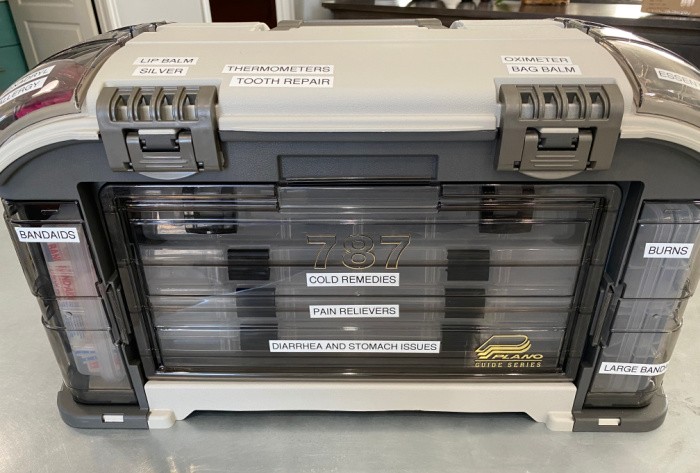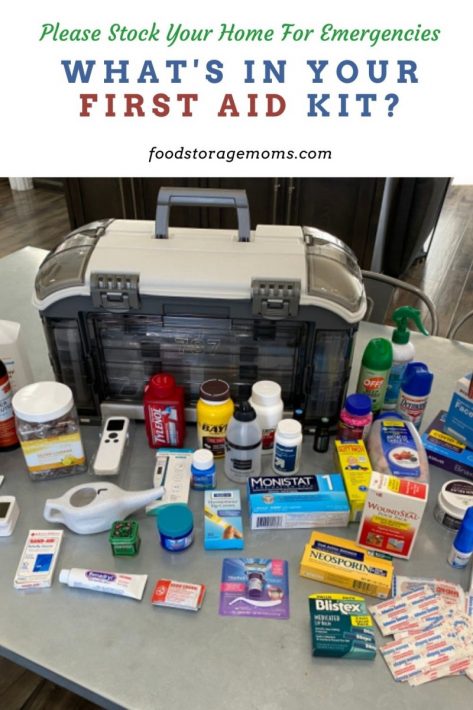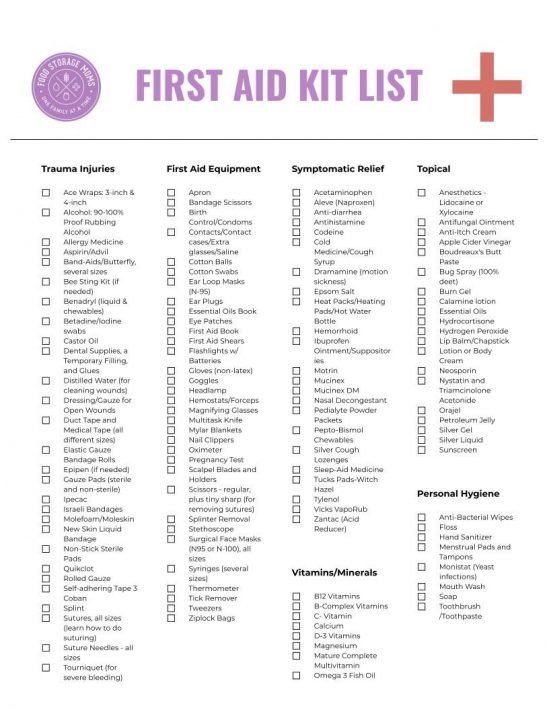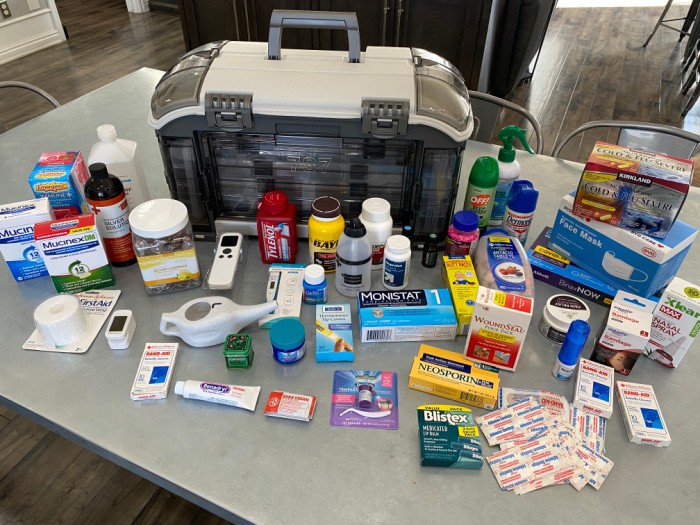
What’s in your first aid kit? Here’s the deal: Most of us have bandages and some Neosporin, maybe some rubbing alcohol or Hydrogen Peroxide. That’s a great start. Keyword “start.”
Today, I want you to consider what you have in your hall closet or first aid kit, whether large or small. The power is out in your neighborhood and your entire city, or at least as far as you can see. There are no lights except the stars, and it’s 10:00 p.m. Yep, it’s called a blackout. There is no power or electricity anywhere.
You have walked across the street to see if the neighbors know what’s happening. No, their lights flickered off as well. Your home phone and cell phone don’t work. There is no internet, and there is no way to hear what has happened. Yes, the radio works, but it’s not telling us what happened in our little community, at least not yet.
Let’s say the power went out on Monday. It’s now Friday of the same week. There is no power. The gas pumps don’t work. I am sure glad I filled the car with gas on Saturday, I think to myself. I don’t need anything from the store, but my neighbors do.
They have driven into town, and the stores are all closed. It’s called a real power outage. No one knows when the power will come back on. Some neighbors become sick and have very little food or water stored, let alone simple first aid kit supplies.
I love this First Aid Kit. It will only hold smaller containers, but that’s okay. I have to rotate them often. It’s perfect for my car or on a pantry shelf. It would be great in my car as well. I had someone make me some new Printables for you to print out. I forgot to have her remove the Zantac, but life happens.
I bought this one: FIRST AID KIT

What’s In Your First Aid Kit?

90 Days’ Worth Of Prescription Medications
My experience, illustrated by my neighbors’ need for food and possibly prescriptions, helped prompt me to update a post I did almost three years ago about first aid kits.
I’m so glad I have 75 days of my 90-day prescriptions filled. Whew, that’s a relief. Some may not be so lucky. What, the pharmacies are closed? Of course, they are; they have no power and no internet. Plus, they don’t have any insurance information about us because the internet doesn’t work without power.
The pharmacies are closed because they are out of basic items that people could pay cash for. Besides, debit cards, credit cards, and EBT cards don’t work. I’m just giving you the heads-up here. Another reason we all need to store some small bills in a safe place is. The other day, Mark went to Smith’s Food King (Kroger), and there was a sign: Closed: Our Computers Do Not Work.
Please check your first aid kit supply today rather than tomorrow. What you have in your house today may be all you have for a week, two weeks, or a month. We all assume the power will come back on, but you get it. We need to be prepared for the unexpected.
The list below is probably much more extensive than most of us consider for a “First Aid Kit.” That could be true, but we have different priorities and needs. The list should be used as a guide and a means to get us brainstorming.
I’m probably over the top with first aid supplies, but that’s how I roll. Let me share the items I like to store, and please add yours to the list. We all use different things, but this will maybe help us think about what we may need to rotate or pick up before an unforeseen emergency happens. I think it will. May God bless our country and families as we deal with many issues.
What’s In Your First Aid Kit?

Please review this list and add the items you and your family use. This is just a start for things that I feel are important. It is extensive and may be considered a full-fledged Emergency Kit that goes beyond first aid considerations.
But better to be overly cautious and best prepared. I will add other items when you let me know your suggestions. I’ve made some short comments in hopes it will prompt thoughts on your part regarding why YOU AND YOUR FAMILY might need the item for your health and safety:
- Ace Wraps / 3-inch & 4-inch: You never know when you might fall on the ice or pull a muscle while playing sports or working out.
- Allergy Medicine: With summer here, allergies could be part of the seasonal change.
- Anti-Bacterial Wipes: The Flu and cold season should prompt more caution and action to keep germs and viruses to a minimum.
- Antifungal Ointment: Our feet seem to be more prone to fungal issues. Have some just in case.
- Anti-Diarrhea: Getting dehydrated from the flu is a real problem. Stopping that diarrhea is a key step to proper hydration.
- Anti-Itch Cream: I’m not sure if it’s the furnace or fans, but my skin gets dry this time of year. A good cream is essential.
- Aleve (Naproxen): Many swear by this pain medication since it’s supposed to last up to twelve hours for mild pain.
- Alcohol: 90-100% proof rubbing alcohol. This item is handy as a first aid antiseptic for massaging muscles and can also be used to clean surfaces. Interesting, but the lower concentrations may prove better since they don’t evaporate as fast.
- Anesthetics, Lidocaine or Xylocaine: used to reduce pain. You may need a prescription for many anesthetics.
- Apple Cider Vinegar: beneficial to clean surfaces / kill germs.
- Aspirin/Advil: used for mild aches and pains. Careful, do not use with infants.
- Baby Wipes are good not only for the baby’s fanny but also for cleaning up other things.
- Bandage Scissors: These scissors are so handy and sharp when cutting thicker bandages.
- Band-Aids/Butterfly, Several Sizes: You can never have too many Band-Aids. Yes, get a good variety for different uses.
- Bee Sting Kit: We may not see many bees this time of year (winter), but again, summer is here now.
- Benadryl, Liquid and Chewable: Benadryl can be used as a mild sleep aid and is great for helping with allergy issues.
- Betadine/iodine swabs: great to use as a germ killer.
- Birth Control: If it’s in your kit, you won’t be as prone to forgetting to take it along when away from home, and as a home backup inventory.
- Boudreaux’s Butt Paste could be a good diaper rash treatment, and it is also good for older folks.
- Bug Spray 100% Deet: a remarkable insect preventative for those who spend much time outside.
- Burn Gel: Burns, whether from the sun, a hot pan, or an open fire, can be painful. This helps heal and suppress pain.
- Calamine Lotion: great for poison ivy, bug bites, scabies, swimmer’s itch, and more.
- Castor Oil can be used for hair treatment, but it is most often used as a laxative to help eliminate constipation.
- Celox: a clotting agent to stop bleeding.
- Cold Medicine/Cough Syrup is pretty self-explanatory. I used to have coughs that lasted a couple of weeks, and this syrup has made all the difference.
- Contacts/Contact Cases/ Extra Glasses/Saline: eye care is critical. You don’t want to be without proper sight during emergencies.
- Condoms: Just as with birth control mentioned above, it’s always good to have a stash at home and in your kit.
- Cotton Balls: These are used for many “applications” of ointments, oils, gels, creams, etc.
- Cotton Swabs: see cotton balls.
- Dental Supplies, a temporary filling, and glues: if you break a tooth or a filling falls out, it’s good to have a backup plan.
- Distilled Water: great for cleaning wounds and CPAPs.
- Dramamine: helps treat motion sickness.
- Dressings for open wounds: Keeping wounds clean and free of dirt and germs is essential.
- Duct Tape and medical tape: I wrote a post about duct tape and its uses; check it out. Get different sizes of both types of tape.
- Ear-Loop Masks (N95): The past couple of years have prompted us to purchase medical masks of all sizes.
- Earplugs are perfect for sensitive ears and are handy if you shoot targets or hunt a lot.
- Elastic Gauze Bandage Rolls: help hold bandages and dressings in place.
- Epsom Salt can be a laxative, but I use it to soak my sore feet.
- Essential Oils Book: The book provides guidance on which essential oils work with different maladies. I like these oils!
- Eye Patches: Hopefully, you won’t experience eye damage when away from home, but a patch could help until you get professional help.
- Fire Extinguisher: A small one could prove very valuable.
- First-Aid Book: These items in your kit are excellent, but the book provides helpful guidance.
- First-Aid Shears: Like bandage scissors, these come in handy for cutting many fabrics and other things.
- Flashlights with Batteries: I like solar flashlights and always have some on my window sills. Remember, for regular flashlights, having different kinds of “fresh” batteries is most critical.
- Floss: Not only do we need to floss when we face emergencies, but this is also great for tying small things together.
- Gloves (non-latex): Protecting our hands is so important. I hate getting blisters if I forget my gloves.
- Gauze Pads (sterile and non-sterile) help to cover and protect cuts, open wounds, blisters, etc. Be careful not to let them stick to burns; removal can be very painful.
- Hand sanitizer: should be used all the time to ward off germs and viruses, not just for first aid purposes.
- Headlamps are beneficial during power outages or at night when you’re outside and don’t have a flashlight.
- Heat packs, heating pads, and hot water bottles help with pain and swelling reduction.
- Hemorrhoid Ointment/Suppositories: You never know when these pesky things will appear; they’re painful.
- Hemostats/Forceps: can be used to hold things in place, and when used carefully, to remove foreign objects.
- Hydrocortisone: removes redness, itching, and swelling.
- Ibuprofen: for minor pain relief.
- Israeli Battle Bandages help to stop bleeding from hemorrhagic wounds and open sores.
- Mylar Blankets: lightweight blankets to protect against hypothermia.
- Lip balm/ ChapStick: helps protect and repair damaged lips. Consider getting some with sun protection.
- Lotion or Body Cream: keeps skin soft and can protect against rash, itching, and more.
- Magnifying Glass: very handy if you have a sliver that needs removal.
- Menstrual Pads and Tampons are good to have, just in case. Pads can also be used to cover open wounds.
- Mucinex: for cough and chest congestion.
- Mucinex Dm: for coughs brought on by colds and bronchitis and to help loosen mucus.
- Motrin: for minor pain relief.
- Monistat (Yeast Infections): The use of antibiotics often causes yeast infections in women. Have some Monistat at home and in your kit.
- Mouthwash not only keeps your breath fresher but can also kill germs that often cause tooth decay.
- Molefoam/Moleskine: very soft cotton fabric that can cover the skin. Also, some versions are said to be windproof.
- Multi-Task Tool: The awesome thing about one of these tools is that it truly is multi-tasking, with a knife, screwdriver, pliers, and more. It is a real space saver.
- Nasal Decongestant: Breathing in every situation is critical to our overall health and well-being.
- Nasal Spray (Afrin): Sometimes, we need a quick fix for nasal issues rather than waiting for a drop or pill to do their thing.
- New Skin Liquid Bandage: Some cuts need extra support to close off and start the healing process, not to mention stopping the bleeding for minor wounds.
- Non-stick Sterile Pads: When closing a wound or covering burns, a pad that doesn’t stick to the affected area is important for healing and softens the pain when it needs to be removed.
- Nystatin and Triamcinolone Acetonide: suitable for treating fungus-related problems.
- Nail Clippers are good for trimming fingernails and toenails and can also cut away small pieces of lost skin and fabric.
- Neosporin: a quality ointment that acts as an antibiotic. Consider using Polysporin for longer-term use.
- Orajel: Sometimes, infected teeth cause pain along the gum line. Apply this for temporary relief.
- Oximeter: If you or family members seem very sick, this handy gadget can tell your heart rate, oxygen percentage, and more.
- Pedialyte Powder Packets: These help children and adults replace vital minerals and nutrients lost, particularly from diarrhea.
- Petroleum Jelly: The most common brand is Vaseline. I recently wrote a post about its benefits.
- Pepto-Bismol Chewables: help to relieve an upset stomach.
- Peroxide has more uses than bleaching hair. It kills germs on small cuts and can be used to clean surfaces.
- Phone Numbers: You may need to contact your doctor, a nurse hotline, Poison Control, a pharmacy, or other key professionals.
- Pregnancy Test: You may not want to wait until an emergency situation is over to determine your status. It could be days or weeks before you experience normalcy in your circumstances. Also, you need to take special care of your body if you are expecting.
- Quickclot: not for large wounds, but can help stop the bleeding for more minor cuts/wounds.
- Rolled Gauze: a true space saver and a means to apply gauze over a larger area by rolling it out.
- Scalpel blades and holders: Most people don’t feel comfortable using a scalpel due to a lack of training, but there could be times when opening a wound to remove debris requires a sharp tool.
- Scissors-regular, plus tiny sharp scissors (for removing sutures): Scissors are a mainstay for many uses at home, in the office, and emergencies.
- Self-adhering Tape: Band-Aids come with the sticky component, but we’ll probably need sticky tape to hold in place gauze, pads, and other materials that we’ve applied to cover cuts and minor wounds.
- Sleep-Aid Medicine: Many people, particularly those prone to joint pain, need a sleep aid to get to and stay asleep.
- Splinter Removal Kit: A sliver or splinter can be very painful. It is vital to have the proper tools to remove them safely.
- Splints: These come in handy when someone has experienced a broken bone and needs the bone stabilized until professional help is available. They come in various sizes, so you’ll want some smaller versions if you have children.
- Soap: Hand washing has been emphasized for months now. It’s important to have soap to clean the area around an open cut or burn. I’d suggest soap bars that can kill the majority of germs and viruses.
- Stethoscope: I’ve never used one, but it wouldn’t hurt to have one to monitor heart status if you have the training or want to learn.
- Surface Mat: You may need to lie down or have others lie down for treatment, and it may not be dry where you are.
- Syringes, several sizes, can be used to administer properly prescribed drugs, like insulin, and clean liquids necessary to clear debris from wounds.
- Sunscreen should be applied before and during periods of sun exposure. Most people don’t use it often enough or in sufficient amounts to be effective.
- Surgical Face Masks (N95 or N100), all sizes: These are your best mask protection. Make sure you have the sizes needed for all family members.
- Sutures, all sizes (learn how to suture): We took a CERT class and practiced on some meat products. It’s good to know how to properly use sutures and how to remove them if necessary.
- Suture needles, all sizes
- Thermometer: If someone is feeling sick, it would be great to know if they have a fever and, if so, what medications to use based on the severity of the fever.
- Tick Remover: If you spend much time in the wild, you’ll need to know how to locate ticks on the skin and properly remove them without leaving the insects’ heads under the skin.
- Toothbrushes/Toothpaste: Even during emergencies, proper dental care is vital to our overall health.
- Tourniquet (for severe bleeding): Stopping excessive bleeding can save a life. The proper use of a tourniquet is necessary so a person’s extremities aren’t put at risk from not receiving enough blood for survival. Get some training!
- Tucks Pads-Witch Hazel: another pad solution to clean and cover open wounds. The Witch Hazel can help with the cleaning and treatment of mild pain.
- Tweezers: great to remove splinters and pick up small items.
- Tylenol: a popular mild pain reliever.
- Vicks VapoRub: great product to help open air passages when you’re congested.
- Whistle: You can yell if you need help, but a whistle works much better.
- Zantac (Acid Reducer) is a good product to consider if a family member experiences frequent upset stomach episodes. As I remember, this one has been taken off the market.
- Ziplock Bags are very useful for storing many of your kit supplies and for carrying out soiled items after use.
- VITAMINS: The next few items cover vitamins and minerals we often take to maintain our health. You’ll want to continue that approach even when in an emergency. The kind and amounts should be taken based on your doctor’s recommendation.
- B-12 Vitamins
- B-complex vitamins
- Calcium
- D-3 Vitamins
- Magnesium
- Mature Complete Multivitamin
- Omega-3 Fish Oil
- Vitamin C
UPDATED PRINTABLE: 2022 First Aid Kit
Other Key Considerations
If you have pets, you need to consider what you will have available if they are hurt or sick.
If you have young children, you may need to consider having items to pass the time if the emergency situation lasts an extended period. The items could be books, games, puzzles, toys, and their favorite stuffed animal or blanket. Some paper, pencils, crayons, markers, coloring books, etc., are also helpful. You should also consider having each child carry some identification in case the family members get separated.
Young families should also consider purchasing more child-related items, such as snacks, burp rags, pacifiers, formula, nursing pads, and infant pain relievers.
My Favorite Medical Books: Dr. Alton’s Antibiotics and Medical Handbook. I know these first aid supplies may be a little over the top for most people, but what if the power is out for two weeks or more and our support infrastructure either wavers or fails?
Final Word
Please take a few minutes today and review what you have in the home or car that will make you more secure than just a simple first aid kit. If you have taken some CPR, EMT, or CERT classes, you rock. Thank you, paramedics, doctors, and first responders. We will need you sooner rather than later. Just think about what’s in your first aid kit today, not tomorrow. May God bless this world, Linda
The post What’s In Your First Aid Kit? appeared first on Food Storage Moms.
from Food Storage Moms
No comments:
Post a Comment